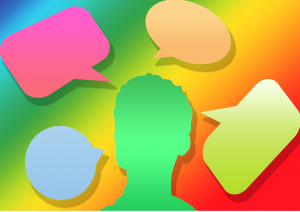I’ve taught and written quite a bit about a favorite methodology of mine called design thinking. It applies to virtually any service design context, and it even mirrors the new Framework for Information Literacy beautifully! At OSU, we’ve used it from everything to helping us re-design our instruction program to helping us work through a recent data needs assessment project.
I’ll talk a little more about how you could use design thinking, but for those of you who might not be familiar with this process, here are the basics. Design thinking is a creative process focused on the generation of solutions stemming from end user needs and wants. This process has several stages: define, ideate, prototype, and learn. Design thinking is championed by IDEO CEO Tim Brown and is an integral part of the curriculum at the Stanford D School.
- Develop empathy and discover user needs in order to determine your design challenge. Try to ask open-ended questions that get people talking. Ask questions neutrally. “What do you think about library instruction?” is a better question than “Don’t you think everyone should bring their classes in for instruction?”Ask “why” instead of “yes” or “no” questions.

- Group findings into categories that represent faculty “problems” and select those to develop further. Take a closer look at your themes and find overlaps and patterns. Write them as problem statements, e.g., “There is a lack of space for students to do their work.” Only keep the information that will help you move forward.
- Detail each pilot service and resource that provides the “solution”. Select the top three to five to focus on and develop further. What gets you excited about the idea? What is the real need that this is addressing? Make a list of all the challenges and barriers you are facing with your idea. What are you missing? Who would oppose the idea? What will be most difficult to overcome? Brainstorm new solutions. Discuss how you can change your concept based on your new ideas. How can you address the need differently? How can you work around the constraints you are facing?
- Evaluate the relevance of the feedback you receive. Implement service prototypes, solicit feedback, and measure their impact in preparation for refining them and scaling up. Define what to test. Is it helpful to first show a rough idea in an informal setting or will you learn the most from seeing your prototype in action? Determine what kind of feedback you are looking for: Do you want to get feedback on the first impression of your idea? Are you trying to learn whether people would participate in a new activity you designed? It’s important to make this as authentic an experience as possible so that you can get realistic information as opposed to discussing a hypothetical situation in which anything works because you haven’t actually tried it. Analyze the feedback you received. What changes would you like to make? What worked well and what didn’t?

- Turn your prototype into a “working” model, service, or tool. Determine if you will need any funding, resources, or staffing to scale it up. This is a conversation you might already have with library administration ahead of your project to ensure that it is fully supported before you begin to design it or you can use this process as a way to request support for a new initiative. Identify potential partners both internal and external who might be involved if they have not already been part of the original planning process.
So how can you use this process to try out a new technology? The point of these activities is not to worry about the tool itself, but rather how it will be utilized and it allows you to step outside of the process of coming up with something from nothing because you are dealing with user issues and challenges which provide the jumping off point for your solutions. Here are a few ideas:
- If you want to try a new resource or approach in class, talk with an instructor to see if he/she will let you interview students and work with them to incorporate the new tool and provide feedback after the instruction using these methods. You can even use these activities as a form of active learning or to design a lesson plan or program itself. The important element is getting user feedback at the beginning of the process so that you’re working with real needs.
- Similarly, if you want to try providing a new service like Virtual Reality, gathering a group of the faculty and students who will be most likely using this service and going through this activity would provide valuable input and will ensure that whatever you implement will be used and useful as opposed to trying to guess what it is they want.
- You can even try this approach with colleagues as a way of introducing them to a new process or cool gadget by taking the anxiety out of the equation. If they are not expected to act as “experts” but rather users, it might be far easier to get some buy-in for your idea and will allow them to learn more as they go, just as you will.
Further resources:
- Tim Brown’s Blog: http://designthinking.ideo.com/
- Design Thinking for Educators Toolkit: http://bit.ly/1SsVSER
- ELI 7 Things You Should Know About Design Thinking: http://bit.ly/24kvDEL
*Images taken from Pixabay